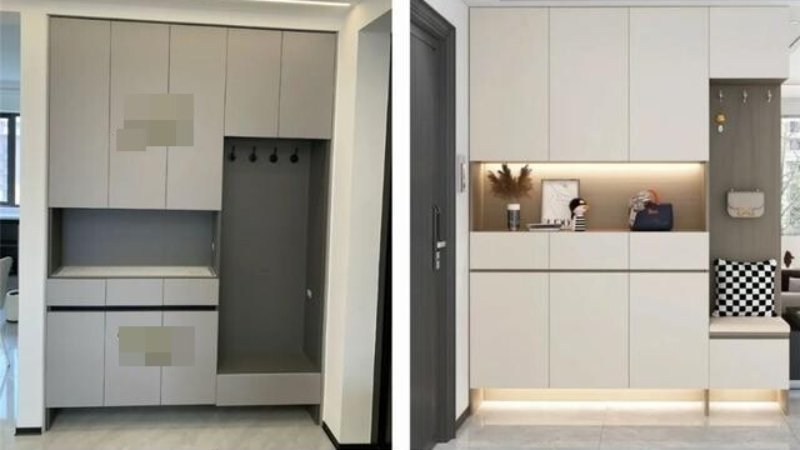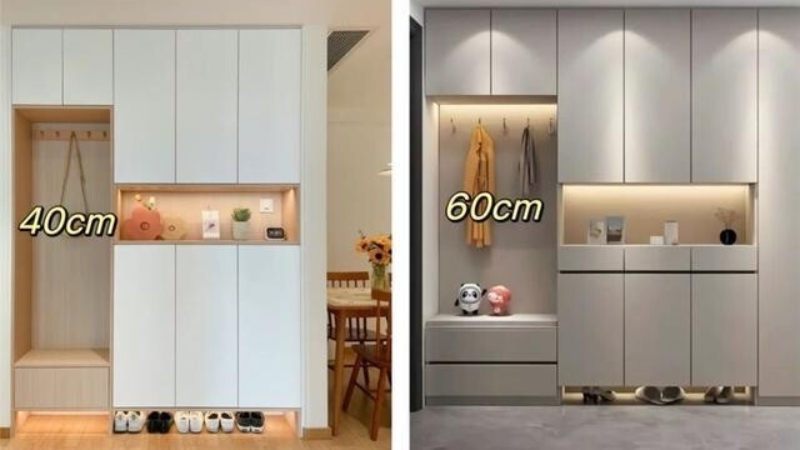A shoe cabinet is not just a place to store your beloved shoes, but it also contributes to the aesthetic beauty of your home. However, not everyone knows how to install a shoe cabinet scientifically and effectively. To solve this problem, this article will share smart tips for installing a shoe cabinet, helping you optimize space and better preserve your shoes, based on the “5 Do’s and Don’ts” rule.
1 Don’t Make a 4-Compartment Cabinet, Make a 5-Compartment One
Based on practical experience, a traditional 4-compartment shoe cabinet often fails to meet the storage needs of many families. The design with one open compartment and a void underneath limits the storage space. This leads to a situation where shoes are scattered everywhere, causing an eyesore and difficulty in finding the right pair.
On the contrary, a 5-compartment shoe cabinet with an additional drawer optimizes space and brings tidiness and order. The drawer is not only used for storing shoes but also can accommodate other small items, increasing convenience for the user.
 Opt for a 5-compartment cabinet instead of a 4-compartment one
Opt for a 5-compartment cabinet instead of a 4-compartment one
2 Depth Should Not Be Less Than 30cm
The minimum depth of a shoe cabinet is crucial. A shoe cabinet with a depth of less than 30cm will struggle to accommodate various shoes, especially men’s shoes and larger sizes. Placing shoes diagonally or horizontally not only wastes space but also reduces aesthetics and causes inconvenience.
To ensure the shoe cabinet meets the storage needs of all family members, an ideal depth should range from 35cm to 40cm.
 Ensure the depth is not less than 30cm
Ensure the depth is not less than 30cm
3 Pay Attention to the Cabinet’s Proportions
To optimize space and create a cabinet that is both aesthetically pleasing and functional, it is essential to focus on the proportions between the different parts.
Design the upper and lower cabinets with equal lengths, combined with an open compartment in the middle, to achieve balance in form and facilitate shoe arrangement and retrieval.
 Pay attention to the cabinet’s proportions
Pay attention to the cabinet’s proportions
4 Avoid Exposed Handles
Instead of the traditional design with exposed handles, modern trends favor handle-less shoe cabinet designs. This solution not only enhances the aesthetics of the living space but also minimizes entanglement and ensures safety for the user.
 Avoid exposed handles
Avoid exposed handles
5 Pay Attention to the Width of the Shoe Cabinet
To ensure convenience and safety when changing shoes, consider the dimensions of the shoe cabinet. If you don’t want to use a separate chair, design the cabinet with a width of at least 40cm on top to comfortably sit and change shoes. A shoe cabinet with a width of about 60cm is an ideal choice, providing enough room to sit and change shoes without taking up too much space.
 Pay attention to the width of the shoe cabinet
Pay attention to the width of the shoe cabinet
Installing a shoe cabinet is not just about organizing your shoes but also an art that creates a neat and aesthetic living space. Applying the “5 Do’s and Don’ts” rule will help you have a shoe cabinet that is both convenient and harmonious with your living area.



































